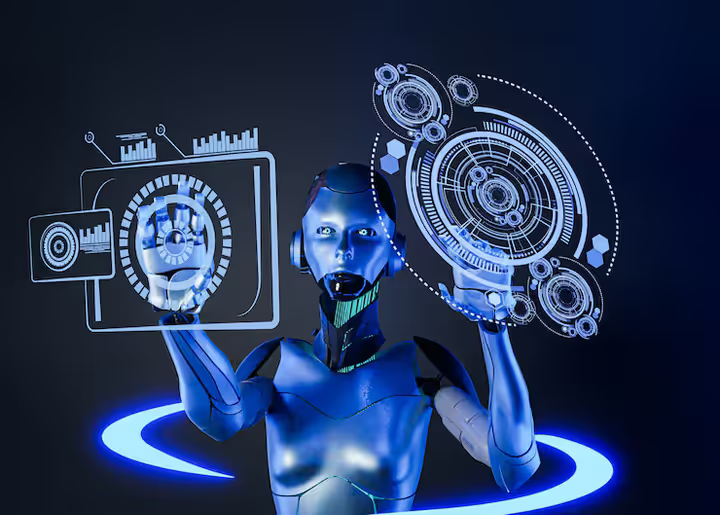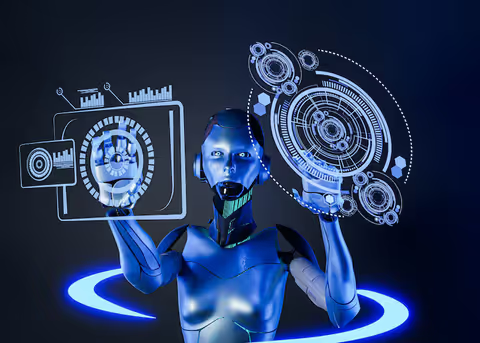
Machine Learning & Artificial Intelligence: Complete Guide and Expert Insights
Artificial Intelligence (AI) refers to systems or software that simulate human-like cognitive functions such as learning, reasoning, and decision-making. Machine Learning (ML), a subset of AI, enables computers to learn from data rather than follow strict programming instructions.
ML exists because traditional programming cannot handle complex, dynamic environments that involve large and unpredictable datasets. With ML, algorithms can generalize from examples, adapt to new data, and make predictions without explicit coding.

The rise of AI and ML became possible due to advancements in computing power, large-scale data availability, and improved algorithms such as neural networks and deep learning. Together, they empower systems to analyze massive datasets, identify patterns, and automate decision-making capabilities that have transformed industries worldwide.
Importance
AI and ML are critical today because they impact nearly every aspect of society, from business efficiency to personal convenience.
-
Automation: AI-driven systems perform repetitive or complex tasks faster and more accurately from chatbots and fraud detection to self-driving vehicles and medical diagnostics.
-
Innovation and Efficiency: Companies adopting AI technologies achieve higher performance, better analytics, and smarter decision-making through predictive modeling and process optimization.
-
Societal Benefits: AI supports breakthroughs in healthcare, education, climate forecasting, agriculture, and governance, helping to solve challenges that humans alone cannot handle at scale.
-
Widespread Impact: AI influences consumers through personalized recommendations, businesses via analytics and optimization, and governments through digital transformation initiatives.
-
Ethical Responsibility: With such broad adoption come challenges bias in models, data privacy concerns, and questions around accountability and human oversight.
Understanding ML and AI is essential not just for technologists but for anyone affected by data-driven decision-making in today’s digital economy.
Recent Updates
The year 2025 has seen major developments in the field of AI and ML.
Broader Adoption and Scaling
Global AI adoption continues to grow. More organizations are integrating AI into business functions such as customer experience, marketing analytics, and operations. Companies are also investing in AI-driven cybersecurity and sustainability solutions.
Evolving Technology and Methods
Key trends shaping 2025 include:
-
Generative AI: Capable of creating text, images, and videos, transforming industries like marketing and design.
-
Smaller, More Efficient Models: “Small Language Models” are gaining traction due to their lower cost and energy consumption.
-
Multimodal Systems: AI that processes text, audio, and images simultaneously to produce richer results.
-
Automated Machine Learning (AutoML): Simplifying the process of building and optimizing models without requiring deep technical expertise.
-
Reinforcement and Agentic AI: Enabling systems to learn by trial and error and make autonomous decisions.
Regulatory and Policy Developments
Governments worldwide, including India, are taking active steps toward responsible AI development. Draft frameworks now require transparency about AI-generated content and mandate ethical guidelines for AI model use. Financial regulators are also creating AI governance frameworks focusing on safety, accountability, and explainability.
These trends demonstrate that AI innovation is no longer just technical it is deeply tied to regulation, ethics, and governance.
Laws or Policies
India’s AI regulatory environment is evolving quickly. While there is no standalone “AI Act,” existing data and IT laws are being extended to cover AI-related risks and responsibilities.
Key Regulatory Developments:
-
AI Governance Guidelines: Introduced by the government to promote ethical and transparent AI, emphasizing fairness, human oversight, accountability, and innovation.
-
Synthetic Content Regulations: New rules require that AI-generated images or videos be clearly labeled to combat misinformation and deepfakes.
-
Responsible AI in Finance: The Reserve Bank of India (RBI) has recommended guidelines to ensure AI systems used by financial institutions are explainable, auditable, and secure.
-
Standards and Certification: The Bureau of Indian Standards (BIS) is working with global standard organizations to establish benchmarks for AI quality, risk management, and data governance.
Core Principles of Responsible AI:
-
Transparency and explainability
-
Fairness and non-discrimination
-
Human-centric design
-
Data protection and privacy
-
Accountability throughout the AI lifecycle
-
Resilience against misuse or malfunction
These principles aim to ensure that AI systems deployed in India remain ethical, secure, and beneficial to all stakeholders.
Tools and Resources
A variety of tools and resources are available to support learning, experimentation, and governance in AI and ML.
Frameworks and Libraries:
-
TensorFlow
-
PyTorch
-
Scikit-learn
-
Keras
Automated and Cloud Platforms:
-
Google Cloud AutoML
-
Microsoft Azure Machine Learning
-
Amazon SageMaker
-
DataRobot
-
H2O.ai
MLOps and Lifecycle Management:
-
MLflow
-
Kubeflow
-
Weights & Biases (W&B)
Data and Model Repositories:
-
Hugging Face Model Hub
-
Kaggle Datasets
-
UCI Machine Learning Repository
Educational and Learning Resources:
-
Online platforms such as Coursera, edX, and Kaggle Learn
-
Research publications and AI Index reports
-
Blogs and communities that discuss evolving ML practices
Templates and Governance Checklists:
-
AI model audit and bias assessment templates
-
AI risk evaluation frameworks
-
Compliance tracking sheets for regulatory alignment
These tools and resources make it easier for individuals and organizations to implement, monitor, and govern AI systems effectively.
FAQs
Q1: What’s the difference between Machine Learning and Artificial Intelligence?
AI is the overarching field focused on creating intelligent systems that can think and act like humans. ML is a subset of AI that uses data and algorithms to train models to make predictions or decisions without being explicitly programmed.
Q2: Why is Machine Learning important?
Machine Learning helps extract actionable insights from large datasets, leading to better predictions, faster automation, and smarter decisions across industries such as healthcare, finance, and manufacturing.
Q3: What are the major trends in AI for 2025?
Key trends include generative AI, smaller efficient models, multimodal systems, ethical AI frameworks, and reinforcement learning-based agents capable of autonomous problem-solving.
Q4: How are governments regulating AI?
Regulations now focus on ethical AI usage, transparency, explainability, bias reduction, and accountability. Many countries, including India, are introducing AI governance guidelines emphasizing responsible innovation and data privacy.
Q5: How can someone start learning Machine Learning?
Start by learning Python, understanding fundamental ML algorithms (supervised, unsupervised, reinforcement), and exploring open datasets. Use beginner-friendly tools like Scikit-learn and TensorFlow, and apply knowledge through small projects and competitions.
Conclusion
Machine Learning and Artificial Intelligence are redefining how the world operates driving efficiency, creativity, and innovation across sectors. However, with these advancements come responsibilities: ensuring fairness, security, and transparency in every stage of AI development.
As we move further into 2025, AI is becoming more powerful yet more regulated. To stay ahead, individuals and organizations must combine technical proficiency with ethical awareness and governance readiness. By leveraging the right frameworks, tools, and principles, AI can continue to evolve as a transformative force that benefits both business and humanity.






